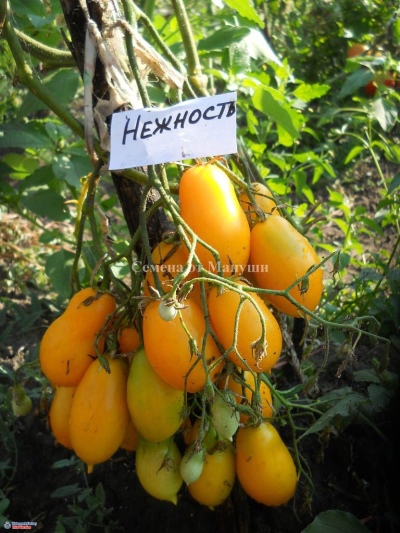
- Authors: Zhidkova V.A., Mikhed V.S., Altukhov Yu.P., Arkhipova T.P., Groshenko A.P., Zvyagintsev V.K., Zhmenya A.A.
- Year of approval: 2000
- Category: grade
- Growth type: indeterminate
- Appointment: fresh consumption, for whole fruit preservation
- Ripening period: mid-season
- Ripening time, days: 113-116
- Growing conditions: for open ground, for film greenhouses
- Marketability: high
- Bush size: tall
Those who are not familiar with the amber “dessert” are presented with a tall, indeterminate variety Tenderness, whose fruits are distinguished by their commercial and decorative qualities. The gorgeous yellow berries belong to the dietary category - they can be used in baby food, and for people who are allergic to red vegetables and fruits. The tomato is grown in all types of greenhouses and in the open field, the fruits are intended for fresh consumption, in salads and sliced. The berry is not suitable for whole-fruit canning because of its thin skin that cannot withstand heat treatment.
Breeding history
Originators of the variety - breeders A.P. Groshenko, V.K. Zvyagintsev, A.A. Zhmenya, V.A. Zhidkova, V.A. Mikhed, Yu.P. Altukhov, T.P. Arkhipova. In the State Register of Breeding Achievements Tomato introduced in 2000.
Description of the variety
Tall (150-180 cm) indeterminate semi-spreading bushes have medium foliage and strong branching. The elongated dissected leaf plate is colored gray-green, has a classic tomato flavor and shape.
Features of the variety:
decorativeness;
strong immunity;
evenness of fruits;
sweet taste and can be used for baby food.
As a disadvantage, one can indicate the tendency to cracking during heat treatment, the need for pinching, tying, shaping.
Flowers are collected in simple inflorescences, the first is laid above 8-9 leaves, all subsequent ones through 1-2 leaf cuttings. The brush lays 7 to 12 berries firmly attached to a regular stem without articulations.
The main qualities of the fruit
The green color with a darker spot at the stalk in the immature stage is replaced by a magnificent sunny yellow color with glossy tints when ripe. The mass of even, strongly pear-shaped berries varies from 100 to 150 grams.
Taste characteristics
The sweet berry has a high beta-carotene content, the juicy tender pulp is covered with a glossy, thin skin. The fruits are used in dietary and baby food, for cosmetic masks, they are useful for people with problems of the cardiovascular system.
Ripening and fruiting
The plant belongs to the mid-ripening category, the stated ripening period is 113-116 days.
Yield
The yield of the variety can be considered satisfactory - from 2.3 to 2.6 kilograms of fruits are harvested from one square meter.
The timing of planting seedlings and planting in the ground
Seeds are laid in the soil 2 months before planting in a permanent place, therefore, for each region, the timing is slightly different, while taking into account the place of cultivation (greenhouse or open ground).

Growing tomato seedlings is an extremely important process, because it largely depends on whether the gardener will be able to harvest at all. All aspects must be taken into account, from seedbed preparation to planting in the ground.
Landing scheme
For optimal development of tomatoes, 2-3 roots are planted per square meter.

Growing and care
Tenderness is grown in the same way as most tomatoes - by the seedling method. Before planting in a permanent place, it is necessary to harden young and delicate plants, prepare them for daily temperature drops and aggressive sunlight.
The soil on the site should be fertile, pH neutral, loose and breathable. Acidic soils are deoxidized with dolomite or bone meal, heavy ones are loosened by the method of introducing cereal husks, sowing siderates. If the crop grows in the open field, adherence to the principles of crop rotation will improve the quality indicators of tomato development. Good predecessors are onions, garlic, cucumbers, carrots, legumes.
The soil in the prepared ridges is enriched with organic matter (humus, compost, bird droppings), complex mineral fertilizers, and wood ash. In the holes, stakes are immediately installed for support, or they equip a trellis. When planting, it is necessary to ensure that the root collar does not end up in the ground. The soil around the stem is compacted and shed well with warm water. The next day, the resulting crust must be loosened to provide oxygen saturation to the roots. The plant requires obligatory tying, pinching, formation of 1-3 stems, and also needs all the traditional measures for growing tomatoes.




A plant needs different micronutrients at each stage of growth. All fertilizers can be divided into two groups: mineral and organic. Folk remedies are often used: iodine, yeast, bird droppings, eggshells.
It is important to observe the rate and period of feeding. This also applies to folk remedies and organic fertilizers.
Disease and pest resistance
Tomato is resistant to bacterial and fungal diseases, but little can be opposed to pests:
aphid;
bear;
whitefly;
spider mite;
May and Colorado beetles.
Preventive treatments with insecticides and fungicides will protect plantings from damage.


Resistant to adverse weather conditions
The variety is well tolerated in short dry periods.
Growing regions
Much to the delight of those who have already become acquainted with the yellow splendor, and other lovers of yellow-fruited tomatoes, the variety is adapted for cultivation throughout Russia and the CIS countries. These are the Central Black Earth Region, northern, North-West, Central, Volgo-Vyatka, North Caucasian, Middle Volga, Lower Volga, Ural, West Siberian, East Siberian and Far Eastern regions, as well as Belarus, Crimea, Kazakhstan and other territories.

























































































